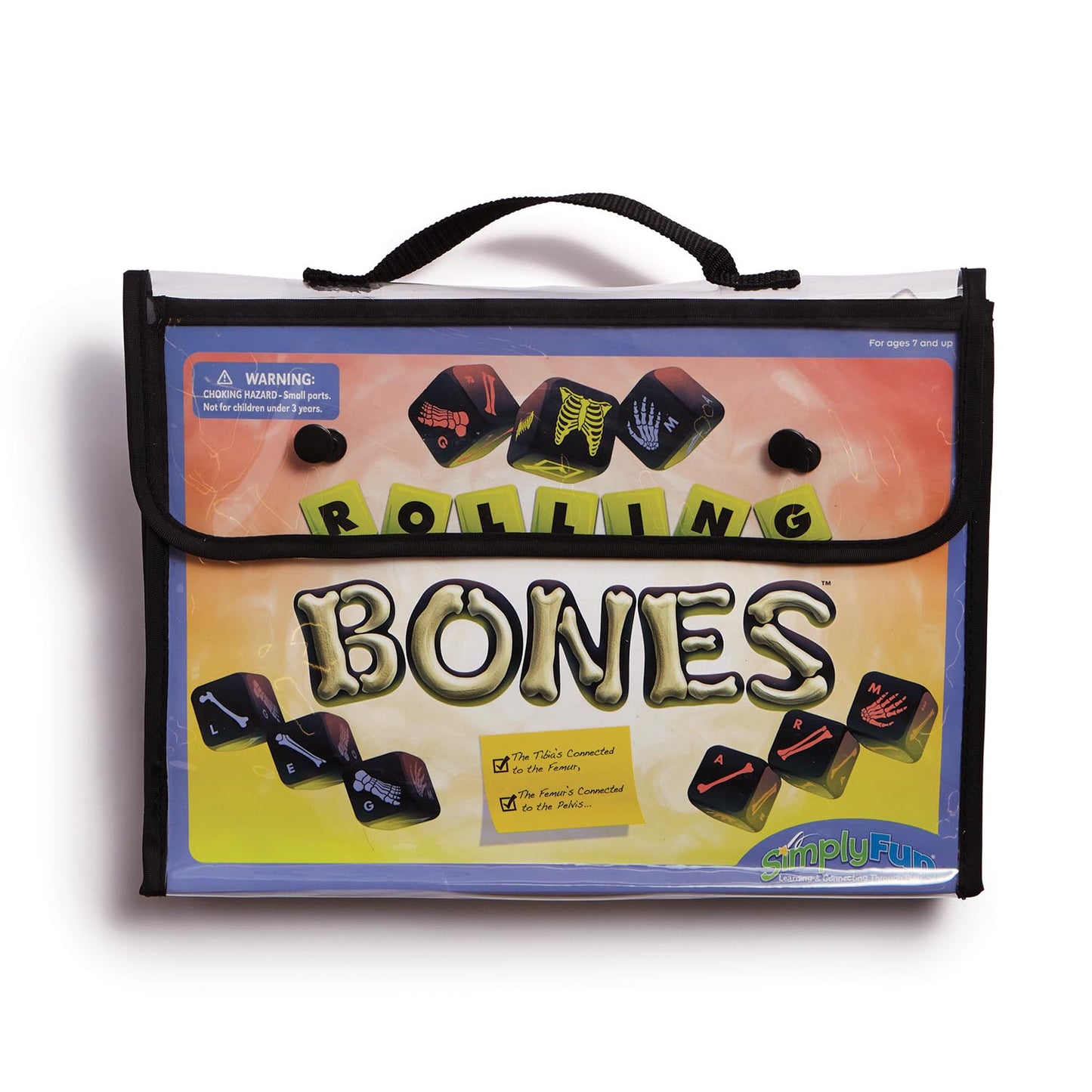
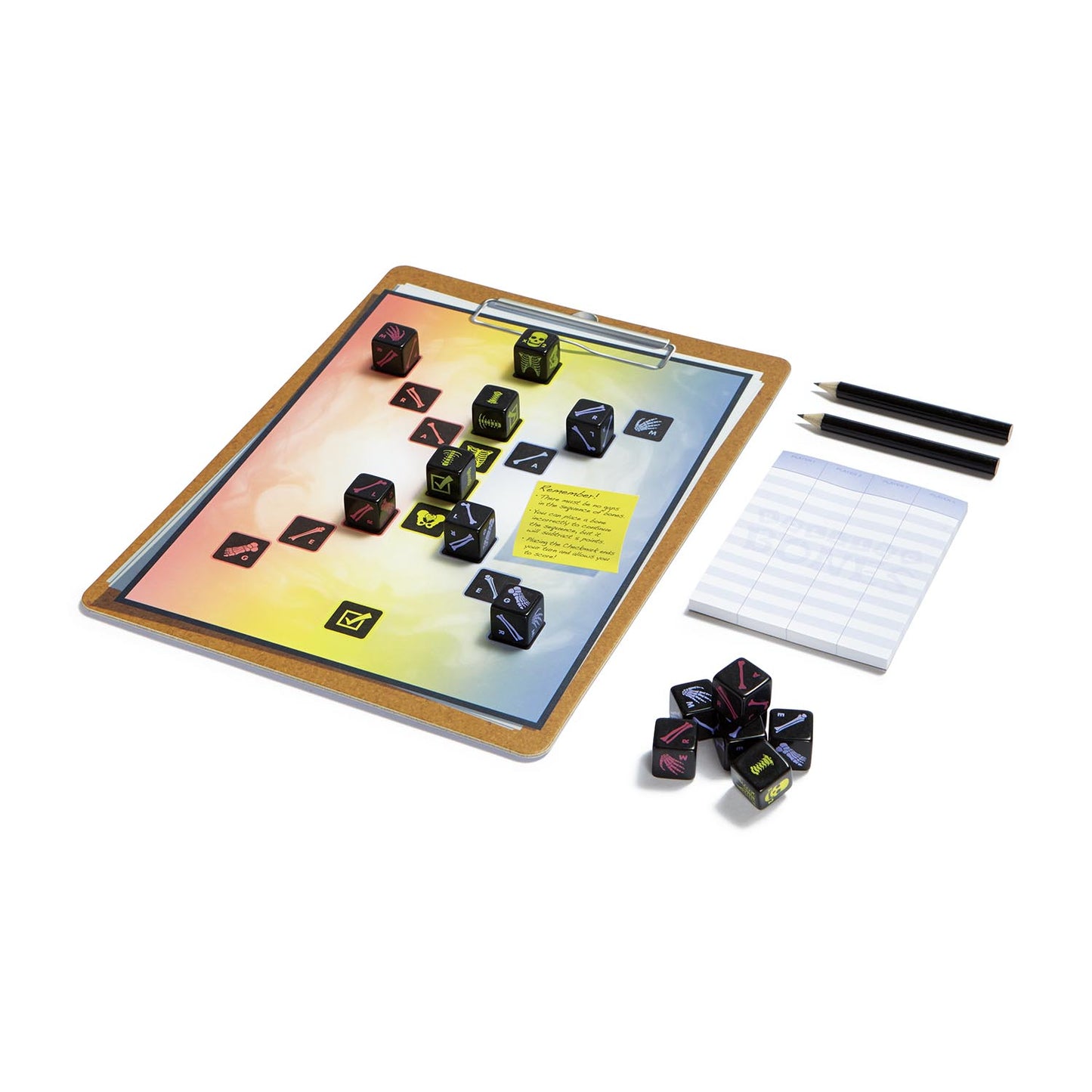
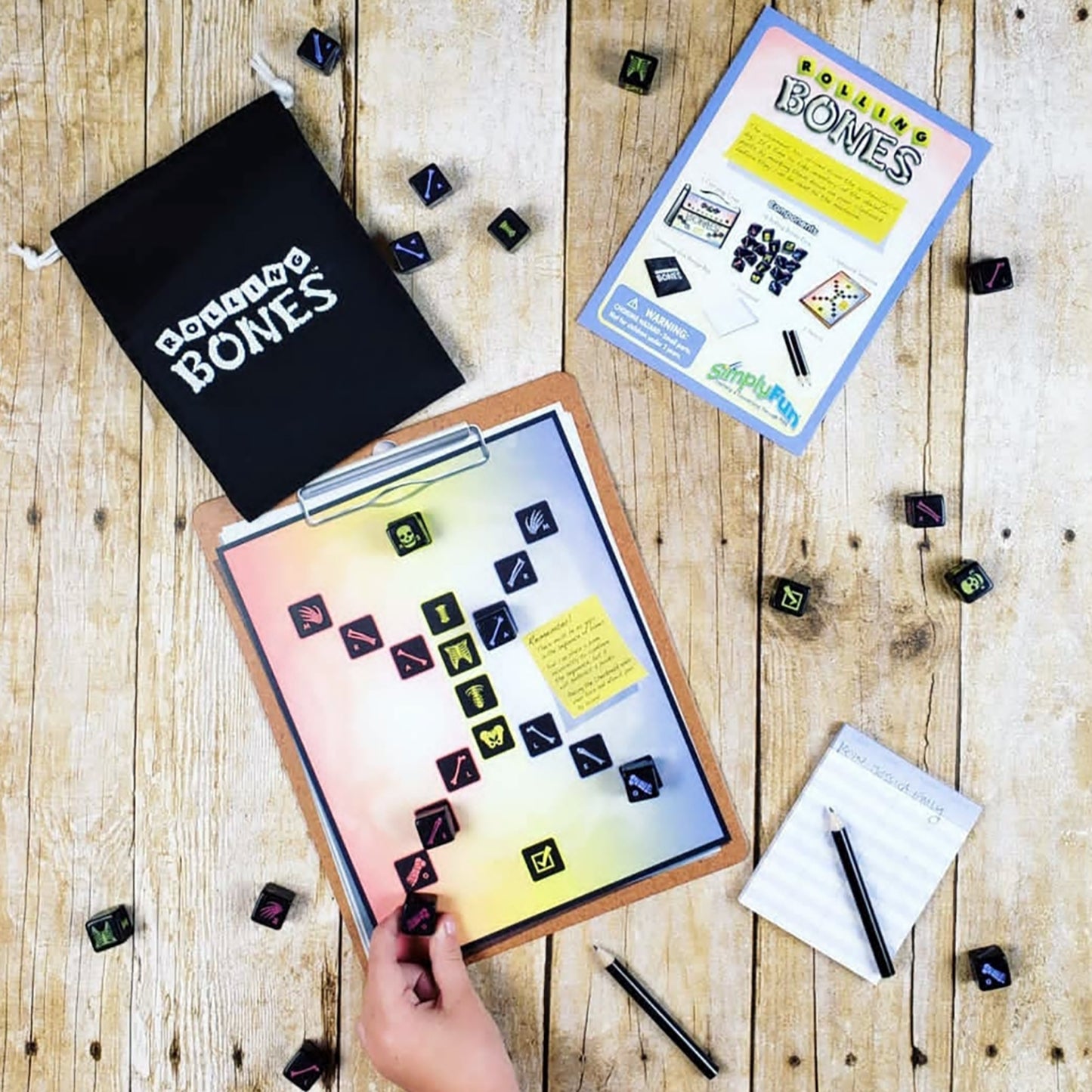
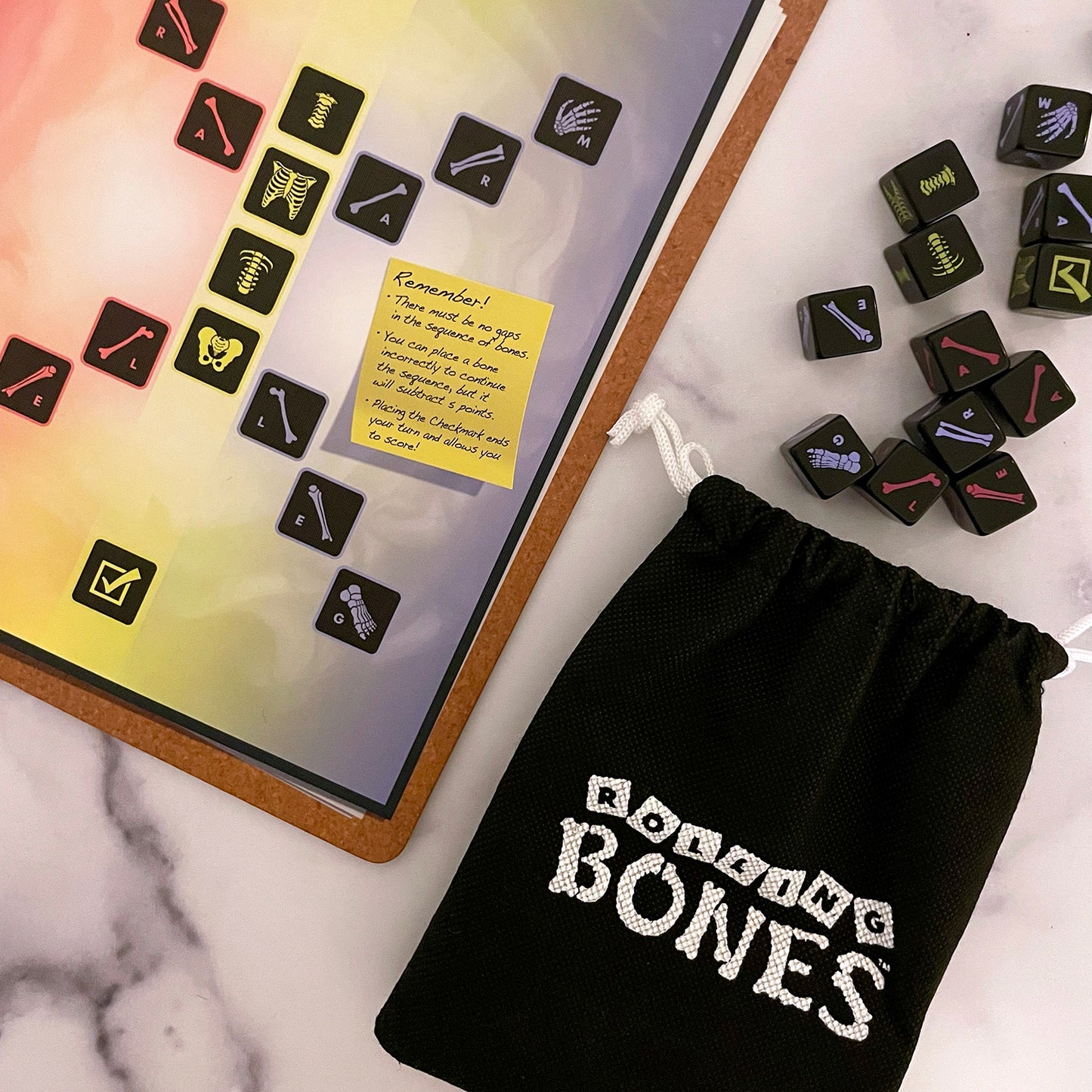
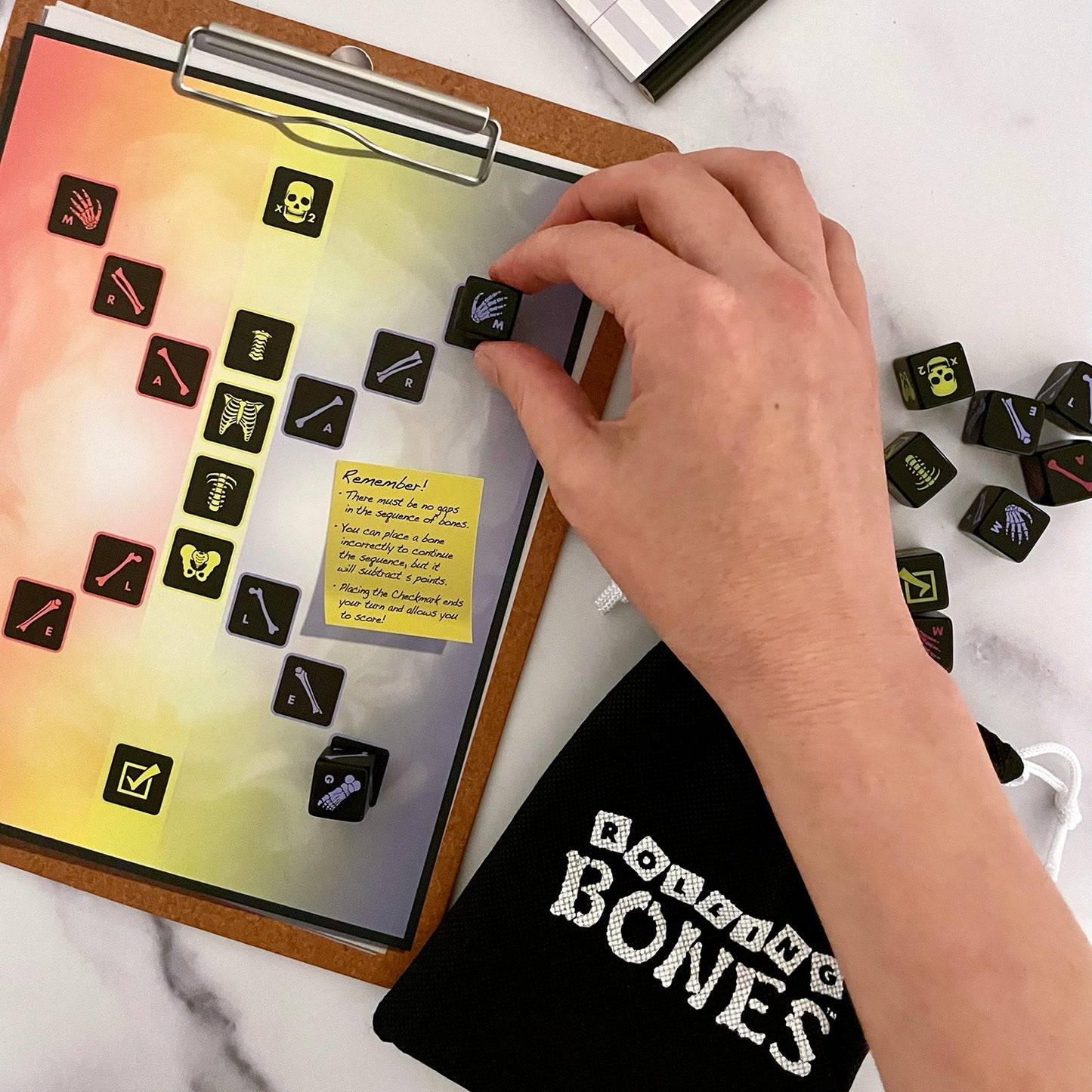
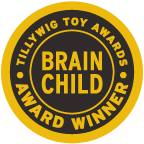
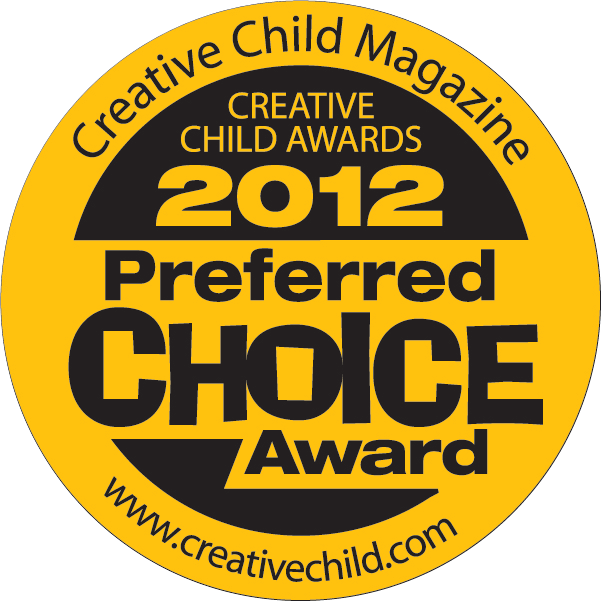

Collapsible content
This is a dice-rolling sequencing game for 2-4 players aged 7 and up.
Rolling Bones comes in a convenient travel bag. Inside are a clipboard template, scorepad and pencils, 18 special dice and a drawstring bag. The object of the game is to rebuild a skeleton as completely as possible and then ship it off to the museum for display.
Rolling Bones teaches the fundamentals of the skeletal system using appropriate anatomical names of our bones. The game also helps teach the correct sequencing of the skeletal structure. But most importantly, the game reinforces decisions around risk and reward... a lesson in probability without even using the 'P Word'
The last person to visit a museum starts the game. Give them the bag with all the dice and have them empty it onto the table.
Now use the clipboard to arrange the dice onto the skeleton template. Note that the skeleton's right side is in red and the left is in blue. Also note that the three parts of each arm are labeled A-R-M and the legs are labeled L-E-G to help you.
Set aside any duplicates.
You can only score bones which are connected, so now you must also remove any disconnected parts from the clipboard. All discarded dice are eligible to be rerolled, and any dice left on the clipboard are locked in. But first, let's see how many points you would have.
You have one connected series of bones on the clipboard. Each die is worth 1 point, however a completed arm, leg or body is worth 5 points instead.
Note there are also two special symbols. The skull and the checkbox. The skull doubles your score. It also is an exception to most of the rules. It doesn't have to connect to any other bone, and it can be taken off the clipboard and rerolled at will.
The checkbox is also a special symbol. In order to ship the skeleton and collect points, you must have rolled a checkbox this turn. No checkbox means you'll have to reroll something and try to get one.
Ok, assuming we chose to reroll, we first have to pay for it. Set aside one of your dice. Each time you reroll, you must pay progressively more dice. The second reroll costs two more dice (a total of three) and the third costs three (a total of six). Don't press your luck too far!
Ok... we got a checkbox on our reroll, so we can place these last few connected dice and take our points.
Note your score on the pad, and pass all the dice to the next player. Continue playing until the first player reaches an agreed upon total: like 50 points.
I should tell you that there's one crazy exception that allows you to put a bone out of its proper order. If you really need the points, you can place a bone in the wrong space and hope no one at the museum will notice! However, doing this will cost you 5 points, so be careful...
Rolling Bones introduces basic human anatomy. It also gives kids a chance to practice decision-making in a risk and reward environment. Learning about predicting and calculating risks is a life skill that will provide long-term benefits. For now, we hope you enjoy the fun of Rolling those Bones!


Core Standard*: Math, Science
Math
- Operations and Algebraic Thinking
- Represent and solve problems involving addition and subtraction. Grade Levels 1st, 2nd
- Add and subtract within 20. Grade Levels 1st, 2nd
- Mathematical Practice
- Look for and make use of structure. Grade Levels 2nd, 3rd
Science
- System
- Whole-Part Relationship
- In grades K-1, students gain fluency in using the concept of part-whole relationships. They agree on names for the parts that make up several types of whole objects, including plants and animals. They learn that objects can be easily taken apart and put back together again, while other objects cannot be taken apart and reassembled without damaging them. Removing one or more parts will usually change how the object functions. Fluency with the part-whole relationship is essential for all of the sciences and is an important building block for more sophisticated understanding of how systems operate in natural and designed environments. Grade Level 1st
- Roll of each Part in a System
- In prior grades students learned to recognize part-whole relationships. In grades 2-3 students learn to think systematically about how the parts of objects, plants, and animals are connected and work together. They realize that the whole object, plant, or animal has properties that are different from the properties of its parts, and that if one or more parts are removed, the whole system may not continue functioning the same way. Students also note cases in which the same part may play a different role in a different system. Finally, they learn to define system as "a group of interacting parts that form a whole." Understanding that an object, plant, or animal is more than the sum of its parts is a deep insight that has value in investigating all natural and human-made systems. Grade Level 2nd
- Life Science
- Structures and Functions of Living Organisms
- Students learn that all living things have basic needs, and they meet those needs in various ways. Just as humans have external body parts that perform different functions to meet their needs, animals and plants also have body parts that perform different functions to meet their needs. A magnifier is a tool that reveals further details of plant and animal parts that are not easily seen with the unaided eye. Learning about the diverse needs of plants and animals and the various ways they meet their needs will help to prepare students to understand more detailed structures beginning at the 2-3 grade band. Grade Level 1st


Explore
What Does Child Do To Use Skill In The Game?
Players explore the dice they throw to discover the which pieces will fit on the skeleton board.
How Parents Can Assist Learning
Encourage children to look at colors, shapes and letters on the dice; and to understand the use of "incorrect bone" placement in order to build sequences. To extend the learning, have them point to the location on their own body where a bone is located that corresponds to a die they play.
Learning Implications and Educator Support
Children will be exploring anatomy and skeletons while playing Rolling Bones. To extend the learning, have them point to the location on their own body where a bone is located that corresponds to a die they play.
Scoring in Rolling involves symbolic meaning, i.e. each die in a sequence equals one point yet a completed arm or leg provides five points.
Encourage children to look at colors, shapes and letters on the dice; and to understand the use of "incorrect bone" placement in order to build sequences.
Determine
What Does Child Do To Use Skill In The Game?
Players determine which pieces will connect in the needed sequence.
How Parents Can Assist Learning
Parents can encourage children to match the dice to the corresponding color. They also need to pay attention to which will connect to core pieces.
Learning Implications and Educator Support
Children need to make risk/reward determinations during their turn. With each roll, they need to decide if it is worth rolling again to gain more points or potentially roll without gaining a Check, and therefore, gain no points.
As children place dice into the correct location on the skeleton, they are learning to sequence the bones accurately. Sequencing is important underlying skill for planning, logical reasoning and other cognitive skills.
Compare
What Does Child Do To Use Skill In The Game?
Players must match color, parts, and/or letters to find the right placement.
How Parents Can Assist Learning
Parents can label the bones and point out directionality. Note the placement of the various multi-bone segments are opposite on the different sides of the body.
Learning Implications and Educator Support
Educators can label the bones and point out directionality. Note the placement of the various multi-bone segments are opposite on the different sides of the body.To extend the learning, have them point to the location on their own body where a bone is located that corresponds to a die they play. Then, discuss the similarities and differences between different body parts (ex: arm and leg) and between the same body parts on different people (ex: how is the foot of an adult different than a that of a child?).
Remember
What Does Child Do To Use Skill In The Game?
Players need to remember that there is a trade off between filling is a space with the wrong piece (and losing 5 points) and adding more pieces to make more segments for additional points.
How Parents Can Assist Learning
When children play the game, they need to take out a die or more with each roll. Remembering the consequences of the choices that were made in previous turns to improve strategic strategy going forward. Remind them of what happened on previous turns. This will help the child think more thoroughly and reduce impulsivity.
Learning Implications and Educator Support
When children play the game, they need to take out a die or more with each roll. Remembering the consequences of the choices that were made in previous turns to improve strategic strategy going forward. Remind them of what happened on previous turns. This will help the child think more thoroughly and reduce impulsivity.
Predict
What Does Child Do To Use Skill In The Game?
Players need to be able to add and subtract potential points to determine the best move. Predicting what the probability of rolling a check mark is. Without a check mark, the turn cannot be ended and the points cannot be counted.
How Parents Can Assist Learning
If you see a child in a situation that is similar to a prior game, remindthem what happened last time. This will help the child think more thoroughly and assess risk/reward of rolling or stopping.
Learning Implications and Educator Support
Predicting involves skills like analysis, observation, hypothesis and memory. Educators can prompt children to practice predicting by asking them to state what they need to roll and what is the likelihood that the will in fact roll that bone(s) or Check Mark.
Playing Rolling Bones requires analyzing the odds of rolling scoring dice and whether the potential additional score is worth the risk of not getting a Check Mark before they have no more dice to roll.
Plan
What Does Child Do To Use Skill In The Game?
Players need thinking about what sequences they are trying to make and to select dice to use in each roll in order to enhance probability of making desired sequences.
How Parents Can Assist Learning
To help children develop strategic plans, ask questions like, "Do you think it would be better to total your score now, or to roll again?" Discuss the trade-offs of taking more/less risk and whether they think it is worth more risk for trying to score more point. After the child's turn, discuss what happened and what they might do similarly or differently next time.
Learning Implications and Educator Support
Planning is an important skill for developing strategic thinking. In this game, children begin to learn risk-reward evaluations that will influence their ultimate strategy. To help children develop strategic plans, ask questions like, "Do you think it would be better to total your score now, or to roll again?" Discuss the trade-offs of taking more/less risk and whether they think it is worth more risk for trying to score more point. After the child's turn, discuss what happened and what they might do similarly or differently next time.Talking aloud will also help with impulsivity, as children are engaging in more thorough analysis of their options and possible consequences.
Practice
What Does Child Do To Use Skill In The Game?
Each turn for a player involves several throws and opportunities to practice strategy. The process of playing the game numerous times leads to better strategies for gaining more points.
How Parents Can Assist Learning
There is no special parent support required. To extend the learning, have them point to the location on their own body where a bone is located that corresponds to a die they play. Then, discuss the similarities and differences between different body parts (ex: arm and leg) and between the same body parts on different people (ex: how is the foot of an adult different than a that of a child?).
Learning Implications and Educator Support
To extend the learning, have them point to the location on their own body where a bone is located that corresponds to a die they play. Then, discuss the similarities and differences between different body parts (ex: arm and leg) and between the same body parts on different people (ex: how is the foot of an adult different than a that of a child?).
Solve
What Does Child Do To Use Skill In The Game?
After playing numerous times, Players can balance risk-taking with conservative play. They may learn that fewer points results in more wins. Players solve their turn by choosing optimal time to place Check on the board, if they have rolled a Check.
How Parents Can Assist Learning
While there is some luck involved in rolling a Check, once it is rolled children have an opportunity to conclude their turn. Encourage children to consider risks and rewards on using the Check Mark or not. Parents can model strategic thinking by sharing their approaches aloud after each turn.
Encourage children to look at colors, shapes and letters on the dice; and to understand the use of "incorrect bone" placement in order to build sequences.
Learning Implications and Educator Support
While there is some luck involved in rolling a Check, once it is rolled children have an opportunity to conclude their turn. Encourage children to consider risks and rewards on using the Check Mark or not. Educators can model strategic thinking by sharing their approaches aloud after each turn.
Scoring in Rolling involves symbolic meaning, i.e. each die in a sequence equals one point yet a completed arm or leg provides five points.
Encourage children to look at colors, shapes and letters on the dice; and to understand the use of "incorrect bone" placement in order to build sequences.
Review
What Does Child Do To Use Skill In The Game?
Players may review if encouraged. See How Parents Can Assist Learning.
How Parents Can Assist Learning
Remind players to think about previous turns and what worked and didn't to get a larger score.
Learning Implications and Educator Support
Remind players to think about previous turns and what worked and didn't to get a larger score.
Demonstrate
What Does Child Do To Use Skill In The Game?
How Parents Can Assist Learning
Learning Implications and Educator Support
Imagine
What Does Child Do To Use Skill In The Game?
How Parents Can Assist Learning
Learning Implications and Educator Support
Create
What Does Child Do To Use Skill In The Game?
How Parents Can Assist Learning
Learning Implications and Educator Support
*Data compiled from CCSSI ELA Standards, WA Science Standards, and Washington Social Studies Standards


Cognitive
Suggestions for How to Modify Play Experience
Put all the dice in the black bag. Have each child draw out one die and throw it. Have them look at the picture of the skeleton and try to identify the bone they picked. Then have them try to feel that bone or bones on their own body. This requires matching the dice to the picture and the picture to the body. Actually feeling the bones helps children understand the meaning of the pictures. For children who are delayed cognitively, modify the process. Have them roll a die. Show them where the bone is on their body so they can feel it. Then have them try to match the die to the part on the skeleton. Give a point for each correct response.
Label body parts associated with the location of the bones. Name a body part and have children find the pictures of the bones in that part of the body. For example, say "Leg." Let children refer to the picture and find the dice that go with the leg. Let them line them up in front of themselves as shown on the chart.
For children who are lower functioning cognitively, modify the directions, so they can place die out of sequence. The goal for them is to understand placement and matching pictures. They will also gain a self confidence if they are able to succeed in constructing a whole skeleton. The adult can discuss the sequence and ask about missing pieces as the game is played. Directions can also be modified so that fewer or no die are removed with each throw.
Communication
Suggestions for How to Modify Play Experience
Walk the child through the directions by demonstrating each step. This will help children with difficulty listening to directions and following them. Breaking up directions with a visual guidance supports memory.
Encourage children to talk while they are placing their pieces. Ask questions to encourage discussion? " Tell us how you know that is where that die goes". Children can be guided to use, size, color, and directionality words and phrases, like "the bigger bone is on this side." The adult can then support the child in learning new vocabulary.
Sensorimotor
Suggestions for How to Modify Play Experience
Put all the dice in the black bag. Have each child draw out one die and throw it. Have them look at the picture of the skeleton and try to identify the bone they picked. Then have them try to feel that bone or bones on their own body. This requires matching the dice to the picture and the picture to the body. Actually feeling the bones helps children understand the meaning of the pictures. For children who are delayed cognitively, modify the process. Have them roll a die. Show them where the bone is on their body so they can feel it. Then have them try to match the die to the part on the skeleton. Give a point for each correct response.
Social Emotional/Behavioral
Suggestions for How to Modify Play Experience
Have a clock, watch or timer on the table. Throw all of the dice into the center of the table. The first player then points to and names a body part and watches the clock. The other children have 10 seconds to find the bones that go with that body part. The lead player calls "Stop" after 10 seconds." Each player gets one point for each correct piece.
Have children play in pairs. This will encourage discussion and collaborative problem solving.
Have children play with a partner. One child points to a body part on the other child. The other child then needs to find that bone from the dice on the table. The first child and/or an adult can check to see if the child found the right die. This modification can be fun to encourage social interaction.
Vision
Suggestions for How to Modify Play Experience
The dice in this game are difficult to see. Use a magnifying glass for the body chart and the dice.
Hearing
Suggestions for How to Modify Play Experience
No modifications required.
*Data compiled from CCSSI ELA Standards, WA Science Standards, and Washington Social Studies Standards


Autism Strengths & Interests
Short Summary of Strengths & Interests
- Is good at making visual matches.
- Likes sequencing objects, especially parts of a skeleton.
- Can think about potential consequences of actions.
Is good at matching visual items
Is This Game Appropriate? Yes
Description
Children who enjoy matching games will enjoy matching the pictures of bones on the dice to pictures of bones on the skeleton game board.
Has a good memory for sensory details, including visual, touch, taste and smell
This game is not appropriate
Has a good memory for words, phrases and dialouge
This game is not appropriate
Has a good memory for pictures, numbers and patterns
This game is not appropriate
Likes to put things in order or a sequence
Is This Game Appropriate? Yes
Description
The bones on the dice must be sequenced in order. Children who like lining up things and sequencing items can enjoy this aspect of Rolling Bones. Bones that are inaccurately placed incur a penalty. This rule can be eliminated, if needed to reduce frustration caused by an inaccurate placement or when children are first learning the game.
Learns through visualizing or "replaying" actions in their mind
This game is not appropriate
Likes activities with rules, such as math and phonics
This game is not appropriate
Is very concrete and literal
This game is not appropriate
Learns in small "chunks" (for example, phone numbers are 3 chunks of number xxx-xxx-xxxx that are combined together)
Is This Game Appropriate? Yes
Description
Some children are strong in learning by "chunks," e.g. they assemble information into a single concept and then combine that with other concepts to create and/or remember something more complex. Rolling Bones is a good match for children who learn this way because players are encouraged to create full sequences of bones, for example an arm, to gain extra points. This will spark learning the sequence of bones for arms, legs, and body in sequenced sets which are then combined together into the entire skeleton.
Is good at nonverbal reasoning and logic
This game is not appropriate
Likes spatial problem solving
This game is not appropriate
Can read well with good vocabulary, though may not fully comprehend content
This game is not appropriate
Likes to use and has good fine motor skill
Is This Game Appropriate? Yes
Description
Players roll the dice and then place dice on the matching bones on the skeleton. This requires some fine motor skill which many children enjoy.
Likes established routines or set ways of doing things
This game is not appropriate
Likes manipulating, constructing or building things
Is This Game Appropriate? Yes
Description
Children with autism may be good at building things with blocks. Rolling Bones is a good match for those children as they manipulate and place dice on the game board to build a skeleton.
Likes to use and has good musical abilities
This game is not appropriate
Likes to use and has good drawing skills
This game is not appropriate
Autism Special Considerations
Appears to ignore other's communication and/or has difficulty giving eye contact to a communication partner
Is This Game Appropriate for Child with Characteristic? Yes
Can Child with Characteristic Play Game w/o Modification? Yes
Strategies for Developing Compensatory Skills:
Eye contact is not needed.
Look at the game instead of each other.
Encourage the child to watch and check all of the dice for each player's turn.
Use unusual or exaggerated inflection to begin a communication about the game. This attracts the child's attention.
Has difficulty understanding complex verbal directions
Is This Game Appropriate for Child with Characteristic? No
Can Child with Characteristic Play Game w/o Modification?
Strategies for Developing Compensatory Skills:
The directions require children to understand sequencing, sections, substitutions, and risk reward. Even if the directions are broken down, remembering the rules may be difficult for children with special needs to play independently. They would need continual prompting.
Uses vocabulary inaccurately or demonstrates echolalia (repeating another's speech)
Is This Game Appropriate for Child with Characteristic? Yes
Can Child with Characteristic Play Game w/o Modification? Yes
Strategies for Developing Compensatory Skills:
No vocabulary is needed except for scoring. Children could play the game with gestures and physical actins.
Respond to immediate echolalia (repeating what was just said) by rephrasing the child's response into a correct format, so the child can hear and repeat that phrase. For example, assume you are playing with a child named Andy and you say, "Your turn," and Andy repeats, "Your turn." You can say, "It's Andy's turn. You say, my turn." This allows the child to hear and repeat the correct response. Eventually, the child will pick up the pattern of response.
Delayed echolalia (repetition of previously heard comments) may have a hidden meaning or association. Look for connection in the phrase used to the current situation. For example, the child says, "After these messages we'll be right back!" Think what the repeated phrase is associated with for the child. Try to interpret what is meant and rephrase it for the child. For example, you might respond by saying, "It sounds like you want a break for a few minutes. Is that what you mean? You can tell me, 'I need a break.'"
Gets stuck repeating a verbal topic or physical actions and/or has difficulty attending to others' actions or topic.
Is This Game Appropriate for Child with Characteristic? Yes
Can Child with Characteristic Play Game w/o Modification? Yes
Strategies for Developing Compensatory Skills:
Children can play without attending to others' turns, but this is not preferred. Players need to check each other's moves and comment on their play.
Practice phrases for commenting on others' play actions. For example, you say to Joe (who is playing with you), "Joe got a whole leg section." Then ask the child, "What did Joe do? "
Remind children about listening and watching others' before making their own comment or action.
Practice turn-taking in conversation. Use a cue, such as a touch on the shoulder, if needed.
Use the child's finger to point to what needs attention. They will attend to their finger first, and then the adult can label the object they are pointing at.
Reinforce attention and actions by commenting on what was done correctly. For example, "You are right. Remove one before you throw again!"
Has difficulty producing speech/communication
Is This Game Appropriate for Child with Characteristic? Yes
Can Child with Characteristic Play Game w/o Modification? Yes
Strategies for Developing Compensatory Skills:
Use augmentative communication, such as picture cards. For example, a picture of person pointing to another person means "your turn."
Words are not needed, but adults can help children learn vocabulary by modeling and encouraging the child to label the parts illustrated on the dice.
Provide at least 10 seconds wait time for the child to process or produce responses. It may take longer to formulate a thought or response for children with special needs.
Has difficulty sequencing multi-step actions and/or doing complex abstract tasks
Is This Game Appropriate for Child with Characteristic? No
Can Child with Characteristic Play Game w/o Modification?
Strategies for Developing Compensatory Skills:
Rolling Bones requires a variety of complex think skills as well as sequencing actions without visual clues. This may be difficult for children with special needs.
Demonstrates difficulty initiating and maintaining social interactions
Is This Game Appropriate for Child with Characteristic? Yes
Can Child with Characteristic Play Game w/o Modification? Yes
Strategies for Developing Compensatory Skills:
Develop a social story to be read at the start of a game. A social story is a short booklet that illustrates how a child can use positive social skills. It includes two to five descriptive statements and a directive statement. For example: "When I watch others, I will know when it is my turn. Others like me when I take turns. I will watch what others do with their pieces and listen to what they say. Others like it when I talk about the game." Add photos or drawings of the child doing the actions described in the story.
Role play social situations and reinforce appropriate words and actions. For example, role play commenting on another player's turn. For instance, "That was a good roll." Use video feedback of positive social behaviors. Video of actual play enables children to see what they or others did. Appropriate actions and interactions can then be discussed.
Acts out or demonstrates avoidance behaviors when frustrated, overwhelmed, or needs more sensory input.
Is This Game Appropriate for Child with Characteristic? Yes
Can Child with Characteristic Play Game w/o Modification? No
Strategies for Developing Compensatory Skills:
Reduce extraneous noise or allow the child to wear head phones or ear plugs if loud sounds cause anxiety.
A weighted vest worn during the game may provide additional pressure input and thus reduce fidgeting due to sensory needs. Pressure can be calming when used for no more than 20 minutes at a time.
Practice a phrase to ask for help and role play situations in the game where it is needed.
Provide techniques for self-calming, such as holding a special toy.
Allow time for movement. For example, a child who needs to move frequently can be given an opportunity to 'celebrate' their turn by running around the table or jumping up and down 10 times.
Has short attention span for non-preferred activities
Is This Game Appropriate for Child with Characteristic? No
Can Child with Characteristic Play Game w/o Modification?
Strategies for Developing Compensatory Skills:
Rolling Bones requires concentration and decision making about what actions to do next. Unless the child is able to maintain the rules in their mind, maintaining attention would be difficult.
Needs sameness or consistent routines and/or has difficulty with transitions from one activity to another
Is This Game Appropriate for Child with Characteristic? Yes
Can Child with Characteristic Play Game w/o Modification? Yes
Strategies for Developing Compensatory Skills:
Play games at the same time every day, so the child anticipates the game routine.
Change the location of the game, so the child may play in different rooms, at the table, or on the floor. This will build tolerance for variation.
Prepare the child ahead time for the introduction of a new game. Talk about aspects that will be motivating for the child, and let them explore the parts of the game before setting out the whole game. Provide a structure for placement of game pieces that can be the same each time the game is played. For example, have a specific location for where the board goes, the pieces, etc. Provide choices for how the child can be involved in set up or clean up. For example, you might ask, " Do you want to set out the board or the frogs?"
Involve the child verbally and with actions for the transition to the game table or at the end of game play. For example, you might say, "Let's look at the pictures on the game box and guess what it is about." Use an object cue. Let the child hold an object from the game or activity you want to introduce prior to the transition. For example, if you were intending to play Rolling Bones you would hand the child a die from the game and say, "Look here is a bone. Let's find the game it goes with?"
Has difficulty understanding others' feelings, intentions, and the reasons for others' actions.
Is This Game Appropriate for Child with Characteristic? Yes
Can Child with Characteristic Play Game w/o Modification? Yes
Strategies for Developing Compensatory Skills:
*Data compiled from CCSSI ELA Standards, WA Science Standards, and Washington Social Studies Standards


Extra Ways to Play the Game
Play Simon Says. Put the dice in a cup. The leader shakes the cup, then pulls one die out. Give a command involving that body part. (Simon Says wiggle your pelvis!) Play it like "Simon Says," and children are "out" if they do the action, but the leader didn't repeat "Simon Says..."
Materials Needed
No additional materials needed.
Developmental Benefits
This is a gross motor game that can be fun when the leader makes up silly actions to do with the body part selected. It also requires careful listening. Let children take turns being the leader and selecting the bones and actions.
Extra Ways to Play the Game
Sing the Skeleton Song. Teach the children the action song below, then let them pick a die out of a cup and sing the phrase that should go with that bone. SEE COMMENT FOR LYRICS. THESE WERE COPIED FROM WEB. MAY BE COPYRIGHTED.
Materials Needed
No additional materials needed.
Developmental Benefits
This action song requires memory and knowledge of body parts. Sequencing is a cognitive task, but adding movement makes it a gross motor game as well.
Extra Ways to Play the Game
Crazy race. The leader throws the dice and line them up without looking at them. The kids line up at the race line on one side of a room. Starting with the first die, the leader shouts out the body part. The children need to figure out how to move forward using that body part. The leader then moves to the next body part, then the next an so on. If a 'check' is called, the children choose which way to move. Encourage them to move in silly ways. See who goes the furthest when all the dice are used.
Materials Needed
No additional materials needed.
Developmental Benefits
This modification encourages children to create new ways to move with their bodies. It is good gross motor practice and requires motor planning skills. Coming up with creative ways to move also employs imagination.
Extra Ways to Play the Game
Build a spooky Halloween tale. Throw the dice and give each child the same number of dice. Start the story, "There once was a skeleton that was all in pieces. A little boy named… and his friend… were walking in the woods looking for wild flowers for their mother's birthday. All of a sudden, …saw a bone on the ground. It was a…(first child names a bone on his dice and places it in the middle of the table). The adult says, "What happened with the bone?.... He wants to find the rest of his bones." The child makes up the next part of the story. The adult then continues telling the story with the second child choosing a die, etc.
Materials Needed
No additional materials needed.
Developmental Benefits
Making up stories is a language arts activity that requires using the imagination. Adults can encourage logical thinking about what each bone might do to find their other body parts. After the adult provides the model for story telling, children can take the lead and make up their own tales.
*Data compiled from CCSSI ELA Standards, WA Science Standards, and Washington Social Studies Standards
- Choosing a selection results in a full page refresh.
- Opens in a new window.









